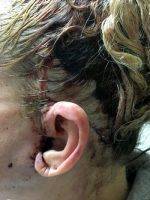Facelift Staples – Plastic Surgeons Opinions
Staples are very commonly used to close incisions, especially in the hair. Staples give a nice result (the scar looks good- maybe not great, but very good), and close the incision quickly, decreasing the operative time. Staples, when used in a facelift surgery, should only be used in the hairline. They should not substitute for a multilayered closure. I prefer sutures for the following reasons:
1. Sutures can approximate tissue more precisely than staples
2. Sutures can stay in place longer and are less likely to leave “track marks” than staples
3. Sutures are less painful to remove in the office than staples
4. Sutures can stay in place for out of town patients along the hair without causing significant issue – staples must be removed relatively soon after the procedure. (Anil R. Shah, MD, Chicago Facial Plastic Surgeon)
Sutures or staples
Personally, I always use sutures when performing a facelift as I feel it gives me more control as a surgeon and I can approximate the suture line better to obtain the most minimal scar possible.
I like to use dissolving sutures as I have found that it is discomforting for patients to have them removed. Staples can be used in the hairline with great success but I feel they are not as exact.
Also, it is uncomfortable to have them removed. It is really not the suture or staple which gives you a good incision line but the talent of the surgeon closing the incision and the tension applied during the facelift. (Jeffrey LaGrasso, MD)
Use of staples in hair bearing areas is indicated because they have less adverse effects on hair growth, do not entangle the hair and are simple to remove. However they may result in punctate scarring if used elsewhere on the face. (J. Brian Boyd, MD, Rolling Hills Estates Plastic Surgeon)
Staples are commonly used in facelift and browlift procedures when the incisions are in the scalp. In most cases they are easier to remove and wont’t tend to get caught in the hair. (Vincent D. Lepore, MD, San Jose Plastic Surgeon)
Staples should not be used to close a facelift.
Much of the final outcome of the facelift is determined by the the quality of the incisions which should be almost imperceptible. This can only be accomplished with a very precise skin closure which is impossible with Staples. (Vincent N. Zubowicz, MD, Atlanta Plastic Surgeon)
In directly seen regions of the face, staples are never a good idea. However, in the hair bearing skin there is no real difference. If you are concerned then talk to your surgeon. Please remember that the most important elements in facelift surgery are the end result and conveying your personal desires/expectations. (James M. Ridgway, MD, FACS, Bellevue Facial Plastic Surgeon)
Staples in facelifts
You would really be surprised how many surgeons use staples on facelifts. Personally, I feel that staple are not, well, very “plastic surgeon- like”, if you see what I mean. Your supposedly paying for a highly skilled artist.
I think using staples are crude. I take the extra time and care to use sutures, even in the hairline.
They give more precise closure and I feel that little details, even in hidden areas like behind the ear, really make a difference in the overall result.
Using sutures is not as easy, but attention to detail really counts in plastic surgery. (Ronald J. Edelson, MD, San Diego Plastic Surgeon)
Staples are used within the hair because they are easy to remove in the office and do not affect the healing in a negative way I would avoid telling the doctor what to do, you can express your concerns and discuss them though
Staples can be used in facelift surgery. Staples can be used in the hair-bearing scalp to close the incision. Personally, I use stitches. Every surgeon has his/her preference. (Earl Stephenson, Jr., MD, DDS, FACS, Atlanta Plastic Surgeon)
In my training and during my first years of practice I used staples in the hair and suture elsewhere. I decided to switch to using sutures everywhere and have experienced better results.
It is a bit more time consuming and requires extra care keeping the suture material from tangling with the hair, but the result is clearly superior.
The wound edges can be more accurately aligned. Sutures tend to have a much lower risk of leaving “rail road tracks” and may be less traumatic to adjacent hair follicles. I remove the sutures after one week, but use suture material that will dissolve after about 2 weeks.
This alleviates the problem of having to find every one of the hundreds of stitches that might be hiding in the hair. (Louis W. Apostolakis, MD, Austin Facial Plastic Surgeon)
It is true that staples are usually used in the hairline. From a surgeon’s standpoint, staples are easier to remove in the hairline than sutures (that can look like hair and get missed).
Staples are definitely not used on the face because they can be unsightly and are not as precise in bringing the skin edges together and thus are more likely to leave a more perceptible scar afterwards.
However, you can develop scarring independent of whether staples or stitches were used. It’s more important that the surgeon is meticulous with the closure and removes stitches or staples at the appropriate time to prevent track marks and scars from forming. (Kristina Tansavatdi, MD, Los Angeles Facial Plastic Surgeon)
There’s nothing wrong with face lift staples in the hair line and behind the ear from a surgeon’s point of view – but After a face lift, staples can really hurt so will only use stitches. (Elizabeth Morgan, MD, PhD, Atlanta Plastic Surgeon)
Staples do well in select locations
Staples, when placed and removed appropriately, heal very well in areas such as the hair line or behind the ear. (Marwan R. Khalifeh, MD, Chevy Chase Plastic Surgeon)
Staples for hairline, Stitches for exposed skin in Facelift closure
There are as many ways to close a facelift incision as there are surgeons doing facelifts. Surgeon’s preference plays a big role in determining which technique is used. As long as the key elements of a good cosmetic closure are being observed then results will be good for either approach.
Staples however should never be used on areas of skin that are exposed or visible such as the skin in front of the ear. They do carry the risk of leaving indentation marks and do not offer the precision closure that stitches do in these visible areas.
Staple can be used very nicely in the area of hair by the temple and along the hairline behind the ear. These areas do have thicker skin and tolerate stapling well and do provide for easier removal and less irritation to the wound when being removed. (Kamran Jafri, MD, New York Facial Plastic Surgeon)
Staples can be used in facelifts and they are usually used behind the ear or at the forehead along the hairline. Its faster and sometimes less traumatizing on the skin. They have to be removed by 8-10 days or they leave scars so if you have early removal, it should be no problem and they are much easier to use around hair. (Curtis Wong, MD, Redding Plastic Surgeon)
Simply put, many surgeons do use staples in the hairline area. No one would use staples anywhere there is a more visible scar. Both can give equally good results if they are not left in for too long.
Staples can be easier to place and remove in the hair bearing scalp, where the incision will be hidden. It’s not necessarily wrong to ask for no staples, but honestly, well placed staples in the scalp will not make a scar worse. (Brian C. Reuben, MD, Salt Lake City Plastic Surgeon)
Well placed sutures have the best results. However, there is more to it than that. The key in closing an incision is to place some internal sutures in the deep layer of skin so that the outside sutures can be removed within 5-7 days.
This accomplishes two things:
- early suture removal (or fast-dissolving external sutures) do not leave visible permanent suture track marks on the skin, and,
- The scar stays more narrow and does not widen as much when deep sutures have been placed in addition to outside sutures.
Staples alone do not provide the needed strength for the wound because once they are removed there are no internal sutures supporting the wound. However, if some internal sutures are placed in addition to the staples, with early removal of the staples to avoid tracks, that would be acceptable. (Ramin Behmand, MD, San Francisco Plastic Surgeon)
Staples are commonly used within the hairline itself, so usually a few staples at most. Within the last week I have seen cases where the entire incision behind the ear was closed with staples, resulting in poor scarring and ‘track’ marks.
In patients with very short hairstyles, or in patients who are bald (men and women), it is best to perform the incisions behind the ears with buried, self dissolving sutures. It is certainly possible to perform the procedure without any staples at all, either with a patient with a full head of hair or in a bald or short-haired patient.
However there are far more important issues in facelift surgery – issues that will have a direct impact on your appearance. (Brent Moelleken, MD, Beverly Hills Plastic Surgeon)
Staples are OK behind the hairline. Sutures should be used for all incisions other than those hidden by hair. I’ve not used any staples to close facelift incisions in a number of years but it’s perfectly fine to use staples in the areas hidden by hair. (Stephen Weber, MD, FACS, Denver Facial Plastic Surgeon)
We use a few staples only behind the hairline because they’re easier to place and remove. We also remove them at 4 days after the procedure to prevent scarring. It is possible to ask your surgeon not to use them.
It is more important to look at the end result of the face lift than to worry about the type of closure. Bad scarring is usually the result of placing too much tension on the skin and leaving the sutures in too long, NOT whether you staples or stitches. (William Portuese, MD, Seattle Facial Plastic Surgeon)
Staples, in my opinion, leave a more noticable scar, so I use suture in all areas of the face and scalp. (Francis R. Palmer, III, MD, Beverly Hills Facial Plastic Surgeon)
For a facelift procedure, stitches are more ideal for a precise closure. With staples, they are a quicker option but are not as precise as stitches, as stitches are done below the skin surface so scarring is less visible.
It’s mostly based on the surgeon’s preference. For my patients, I use stitches to close the incision for optimal healing and minimal scarring. My advice to you is to talk it over with your surgeon about your concerns and to understand his technique in using staples over sutures.
It’s crucial to feel comfortable and confident in your surgeon for any cosmetic procedure – if you are still not convinced this is the best option for you, seeking a second opinion is always an option as well. (Michael K. Obeng, MD, FACS – Account Suspended, Beverly Hills Plastic Surgeon)
Staple and suture use is really an issue of surgeon preference. Generally speaking, staples, if used at all, are placed in the hair-bearing area of the scalp, and are rarely used on the skin near the front of the ear or on the back crease of the ear.
In my practice, I do not use staples in any aspect of my surgical closure. I would probably recommend leaving it up to the discretion of your doctor. (Jeffrey B. Wise, MD, FACS, Wayne Facial Plastic Surgeon)
The debate of staples vs. stitches relates to the closure of your facelift incision which is located within the scalp/hair. Many surgeons prefer staples in the hair, as they are easier to see and less painful to remove in the office.
Sutures within the hair can be difficult to see and sometimes harder to remove. Both provide equal and excellent skin closure if done in a proper technical fashion. In regard to any incision around the ear or adjacent to the hairline, I prefer a subcuticular (under the skin) closure, such there are no visible sutures or knots.
This allows for optimal healing in the skin incision. (Paul S. Gill, MD, Houston Plastic Surgeon)
The advice that you got from your consult doctor is true. Exposed areas of the face are best closed with stitches placed below the surface of the skin so that stitch marks, i.e. railroad tracts, do not happen.
Staples are quicker and kinder to hair follicles, but are not as precise as stitches in the closure of skin incisions. I would not demand anything from my surgeon and start an adversarial relationship unless you have a good reason.
Talk out the options, listen to his reasoning and make your decision. Remember that you and your surgeon are about to embark on a long, and hopefully, successful journey. (Robert E. Zaworski, MD, Atlanta Plastic Surgeon)
Using staples or not during a facelift is determined by the preference of the surgeon. I do not believe that staples cause more scarring than sutures and my preference is to use staples around the hair bearing incisions, and sutures around the skin of the ear. (Michael I. Echavez, MD, San Francisco Facial Plastic Surgeon)










